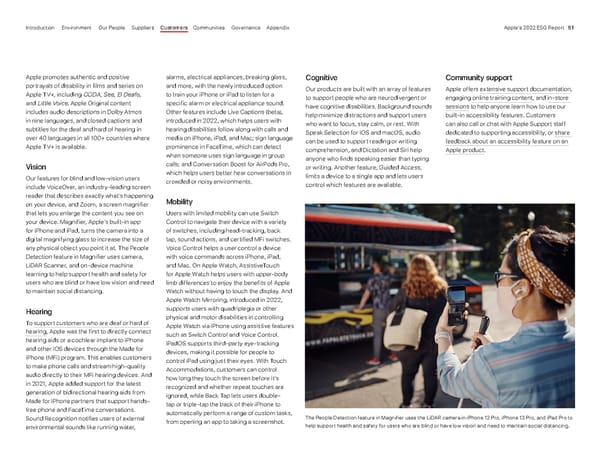Apple promotes authentic and positive portrayals of disability in films and series on Apple TV+, including CODA , See , El Deafo , and Little Voice . Apple Original content includes audio descriptions in Dolby Atmos in nine languages, and closed captions and subtitles for the deaf and hard of hearing in over 40 languages in all 100+ countries where Apple TV+ is available. Vision Our features for blind and low-vision users include VoiceOver, an industry-leading screen reader that describes exactly what’s happening on your device, and Zoom, a screen magnifier that lets you enlarge the content you see on your device. Magnifier, Apple’s built-in app for iPhone and iPad, turns the camera into a digital magnifying glass to increase the size of any physical object you point it at. The People Detection feature in Magnifier uses camera, LiDAR Scanner, and on-device machine learning to help support health and safety for users who are blind or have low vision and need to maintain social distancing. Hearing To support customers who are deaf or hard of hearing , Apple was the first to directly connect hearing aids or a cochlear implant to iPhone and other iOS devices through the Made for iPhone (MFi) program. This enables customers to make phone calls and stream high-quality audio directly to their MFi hearing devices. And in 2021, Apple added support for the latest generation of bidirectional hearing aids from Made for iPhone partners that support hands- free phone and FaceTime conversations. Sound Recognition notifies users of external environmental sounds like running water, alarms, electrical appliances, breaking glass, and more, with the newly introduced option to train your iPhone or iPad to listen for a specific alarm or electrical appliance sound. Other features include Live Captions (beta), introduced in 2022, which helps users with hearing disabilities follow along with calls and media on iPhone, iPad, and Mac; sign language prominence in FaceTime, which can detect when someone uses sign language in group calls; and Conversation Boost for AirPods Pro, which helps users better hear conversations in crowded or noisy environments. Mobility Users with limited mobility can use Switch Control to navigate their device with a variety of switches, including head-tracking, back tap, sound actions, and certified MFi switches. Voice Control helps a user control a device with voice commands across iPhone, iPad, and Mac. On Apple Watch, AssistiveTouch for Apple Watch helps users with upper-body limb differences to enjoy the benefits of Apple Watch without having to touch the display. And Apple Watch Mirroring, introduced in 2022, supports users with quadriplegia or other physical and motor disabilities in controlling Apple Watch via iPhone using assistive features such as Switch Control and Voice Control. iPadOS supports third-party eye-tracking devices, making it possible for people to control iPad using just their eyes. With Touch Accommodations, customers can control how long they touch the screen before it’s recognized and whether repeat touches are ignored, while Back Tap lets users double- tap or triple-tap the back of their iPhone to automatically perform a range of custom tasks, from opening an app to taking a screenshot. Cognitive Our products are built with an array of features to support people who are neurodivergent or have cognitive disabilities. Background sounds help minimize distractions and support users who want to focus, stay calm, or rest. With Speak Selection for iOS and macOS, audio can be used to support reading or writing comprehension, and Dictation and Siri help anyone who finds speaking easier than typing or writing. Another feature, Guided Access, limits a device to a single app and lets users control which features are available. The People Detection feature in Magnifier uses the LiDAR camera in iPhone 12 Pro, iPhone 13 Pro, and iPad Pro to help support health and safety for users who are blind or have low vision and need to maintain social distancing. Community support Apple offers extensive support documentation , engaging online training content , and in-store sessions to help anyone learn how to use our built-in accessibility features. Customers can also call or chat with Apple Support staff dedicated to supporting accessibility, or share feedback about an accessibility feature on an Apple product . Appendix Governance Communities Suppliers Customers Our People Environment Introduction Apple’s 2022 ESG Report 51
 ESG Report | Apple Page 50 Page 52
ESG Report | Apple Page 50 Page 52